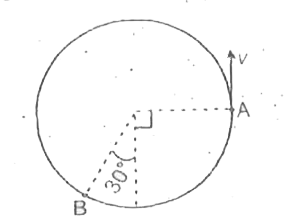A particle of mass m moves with constant speed v on a circular path of radius r. Find magnitude of average force on it in half revolution.
To find the magnitude of the average force on a particle of mass m moving with constant speed v on a circular path of radius r during half a revolution, we can follow these steps:
Step 1: Understand the motion of the particle
The particle moves in a circular path with constant speed v. During half a revolution, the particle moves from one point on the circle to the point directly opposite it.
Step 2: Determine the initial and final velocities
- Initial velocity (→vi): At the starting point, we can assume the velocity is directed upwards, which can be represented as →vi=v^j.
- Final velocity (→vf): After half a revolution, the particle will be at the bottom of the circle, and its velocity will be directed downwards, represented as →vf=−v^j.
Step 3: Calculate the change in velocity
The change in velocity (Δ→v) can be calculated as:
Δ→v=→vf−→vi=(−v^j)−(v^j)=−2v^j
Step 4: Determine the time taken for half a revolution
The time period (T) for one complete revolution is given by:
T=2πrv
Thus, the time for half a revolution is:
t=T2=πrv
Step 5: Calculate the average acceleration
Average acceleration (→aavg) is given by the change in velocity divided by the time taken:
→aavg=Δ→vt=−2v^jπrv=−2v2πr^j
Step 6: Calculate the average force
Using Newton's second law, the average force (→Favg) can be calculated as:
→Favg=m→aavg=m(−2v2πr^j)=−2mv2πr^j
Step 7: Find the magnitude of the average force
The magnitude of the average force is:
|→Favg|=2mv2πr
Thus, the magnitude of the average force on the particle during half a revolution is:
2mv2πr
The particle moves in a circular path with constant speed v. During half a revolution, the particle moves from one point on the circle to the point directly opposite it.
- Initial velocity (→vi): At the starting point, we can assume the velocity is directed upwards, which can be represented as →vi=v^j.
- Final velocity (→vf): After half a revolution, the particle will be at the bottom of the circle, and its velocity will be directed downwards, represented as →vf=−v^j.
The change in velocity (Δ→v) can be calculated as:
Δ→v=→vf−→vi=(−v^j)−(v^j)=−2v^j
The time period (T) for one complete revolution is given by:
T=2πrv
Thus, the time for half a revolution is:
t=T2=πrv
Average acceleration (→aavg) is given by the change in velocity divided by the time taken:
→aavg=Δ→vt=−2v^jπrv=−2v2πr^j
Using Newton's second law, the average force (→Favg) can be calculated as:
→Favg=m→aavg=m(−2v2πr^j)=−2mv2πr^j
The magnitude of the average force is:
|→Favg|=2mv2πr
2mv2πr
Similar Questions
A particle of mass m moves with constant speed v on a circular path of radius r as shown in figure. The average force on it during its motion from A to B is

View SolutionA particle of mass M moves with constant speed along a circular path of radius r under the action of a force F. Its speed is
View SolutionA particle is moving with speed v in a circle of radius R. Find the magnitude for average velocity of point
for the half revolution
View SolutionAn object of mass m moves with constant speed in a circular path of radius r under the action of a force of constant magnitude F. the kinetic energy of object is
View SolutionAn object of mass 5 kg moves at a constant speed of 6 m/s in a circular path of radius 2m. Find the magnitude of the object's acceleration and the net force responsible for its motion.
View SolutionA body revolves with constant speed v in a circular path of radius r. the magnitude of its average acceleration during motion between two points in diametrically opposite direction is
View SolutionA particle moves with constant speed v along a circular path of radius r and completes the circle in time T. The acceleration of the particle is
View SolutionA particle of mass m is moving on a circular path of radius r with uniform speed v , rate of change of linear momentum is
View SolutionA particle is moving with a constant speed in a circular path. Find the ratio of average velocity to its instantaneous velocity when the particle rotates an angle θ=(π2) .
View SolutionA particle of mass 'm' is moving on a circular path of radius 'r' with uniform speed 'v'. Rate of change of linear momentum is
View Solution
